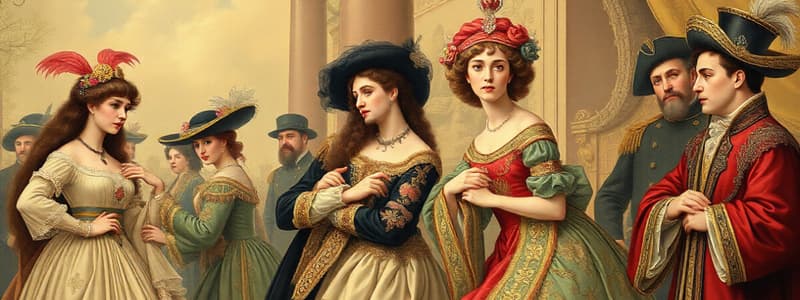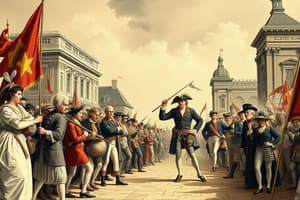Podcast
Questions and Answers
What was one of the significant economic factors that contributed to the French Revolution?
What was one of the significant economic factors that contributed to the French Revolution?
- The rise of agricultural productivity
- High prices and bad harvests (correct)
- Adequate taxation on the privileged classes
- A decrease in foreign trade
Which Enlightenment thinker is NOT mentioned as having raised disturbing questions that influenced the French Revolution?
Which Enlightenment thinker is NOT mentioned as having raised disturbing questions that influenced the French Revolution?
- Locke
- Voltaire
- Montesquieu (correct)
- Rousseau
Which of the following was a characteristic of the Old Regime in France during the 1770s?
Which of the following was a characteristic of the Old Regime in France during the 1770s?
- All estates had equal access to government positions
- Two estates had privileges and exemptions from taxes (correct)
- The Third Estate was exempt from taxes
- Clergy owned no land in France
What significant event is often used to symbolize the beginning of the French Revolution?
What significant event is often used to symbolize the beginning of the French Revolution?
What percentage of the land did the Second Estate own despite being only 2 percent of the population?
What percentage of the land did the Second Estate own despite being only 2 percent of the population?
Which social class was taxed heavily under the Old Regime?
Which social class was taxed heavily under the Old Regime?
Which group in the Third Estate consisted of bankers, factory owners, and professionals?
Which group in the Third Estate consisted of bankers, factory owners, and professionals?
How did the clergy and nobility generally view Enlightenment ideas?
How did the clergy and nobility generally view Enlightenment ideas?
Which group was the second and poorest within the Third Estate?
Which group was the second and poorest within the Third Estate?
What is a characteristic of the bourgeoisie within the Third Estate?
What is a characteristic of the bourgeoisie within the Third Estate?
Which group made up the majority of the population in France in 1787?
Which group made up the majority of the population in France in 1787?
Which statement accurately reflects the beliefs of the First Estate during the period leading up to the French Revolution?
Which statement accurately reflects the beliefs of the First Estate during the period leading up to the French Revolution?
What was a key characteristic of the Second Estate in 1787?
What was a key characteristic of the Second Estate in 1787?
How did members of the Third Estate generally feel towards the First and Second Estates?
How did members of the Third Estate generally feel towards the First and Second Estates?
Which group had the least power to influence the government?
Which group had the least power to influence the government?
What percentage of income was typically paid in taxes by members of the First Estate?
What percentage of income was typically paid in taxes by members of the First Estate?
In what way did the Second Estate disagree about Enlightenment ideas?
In what way did the Second Estate disagree about Enlightenment ideas?
What role did the bourgeoisie play within the Third Estate?
What role did the bourgeoisie play within the Third Estate?
Which of the following statements about the population distribution in France in 1787 is correct?
Which of the following statements about the population distribution in France in 1787 is correct?
What did the members of the Third Estate embrace that differentiated them from the other estates?
What did the members of the Third Estate embrace that differentiated them from the other estates?
What economic conditions in France during the 1700s contributed to social unrest?
What economic conditions in France during the 1700s contributed to social unrest?
How did Enlightenment thinkers influence the sentiments of the Third Estate in France?
How did Enlightenment thinkers influence the sentiments of the Third Estate in France?
Describe the privileges held by the First and Second Estates under the Old Regime.
Describe the privileges held by the First and Second Estates under the Old Regime.
Explain the significance of the National Assembly in the context of the French Revolution.
Explain the significance of the National Assembly in the context of the French Revolution.
What role did the Great Fear play in the early stages of the French Revolution?
What role did the Great Fear play in the early stages of the French Revolution?
How did the economic disparities within the Third Estate influence their social dynamics?
How did the economic disparities within the Third Estate influence their social dynamics?
What role did the Enlightenment ideals play in shaping the aspirations of the bourgeoisie?
What role did the Enlightenment ideals play in shaping the aspirations of the bourgeoisie?
What was the general attitude of the nobility towards the socioeconomic conditions of the Third Estate?
What was the general attitude of the nobility towards the socioeconomic conditions of the Third Estate?
In what ways did the contributions of the First and Second Estates to the government differ from those of the Third Estate?
In what ways did the contributions of the First and Second Estates to the government differ from those of the Third Estate?
How did the perspectives of the clergy and nobility on Enlightenment ideas impact their authority in society?
How did the perspectives of the clergy and nobility on Enlightenment ideas impact their authority in society?
Flashcards
Old Regime
Old Regime
The social and political system of France in the 1770s, characterized by three estates with different privileges.
Three Estates
Three Estates
France's social classes in the 1770s – the First, Second, and Third Estates – with varying rights and privileges.
Privileged Estates
Privileged Estates
The First and Second Estates in pre-revolutionary France, who enjoyed special rights and exemptions from taxes.
French Revolution Causes
French Revolution Causes
Signup and view all the flashcards
Enlightenment Ideas
Enlightenment Ideas
Signup and view all the flashcards
Second Estate
Second Estate
Signup and view all the flashcards
Third Estate
Third Estate
Signup and view all the flashcards
Bourgeoisie
Bourgeoisie
Signup and view all the flashcards
Urban Workers
Urban Workers
Signup and view all the flashcards
First Estate
First Estate
Signup and view all the flashcards
Urban Lower Class
Urban Lower Class
Signup and view all the flashcards
Peasant Farmers
Peasant Farmers
Signup and view all the flashcards
Social Unrest
Social Unrest
Signup and view all the flashcards
Economic Inequality
Economic Inequality
Signup and view all the flashcards
High Taxes
High Taxes
Signup and view all the flashcards
What fueled the French Revolution?
What fueled the French Revolution?
Signup and view all the flashcards
Clergy's Privilege
Clergy's Privilege
Signup and view all the flashcards
Noble's Power
Noble's Power
Signup and view all the flashcards
Bourgeoisie's Beliefs
Bourgeoisie's Beliefs
Signup and view all the flashcards
Third Estate Burdens
Third Estate Burdens
Signup and view all the flashcards
Urban Workers' Hardship
Urban Workers' Hardship
Signup and view all the flashcards
Study Notes
The French Revolution - Key Events and Figures
- Old Regime: France's social and political system in the 1700s, divided into three estates.
- First Estate: The clergy of the Roman Catholic Church; owned 10% of land, provided education and relief, but paid little tax.
- Second Estate: The rich nobles; owned 20% of the land, held high offices, paid almost no taxes.
- Third Estate: 97% of the population; diverse groups (bourgeoisie, urban workers, and peasants), resented privileges of the top two estates, heavily taxed.
- Bourgeoisie: The middle class (bankers, factory owners, merchants, professionals), well-educated, believed in Enlightenment ideals.
- Urban workers: Tradespeople, apprentices, laborers, and domestic servants, low wages, frequently unemployed.
- Peasants: Largest group in the Third Estate, heavily taxed, paid dues to nobles and tithes to the Church.
- Louis XVI: King of France, indecisive and weak leader, extravagant spending, inherited and added to national debt.
- Marie Antoinette: Queen of France, unpopular due to spending habits and Austrian ties, further strained public opinion.
- Estates-General: Assembly of representatives from all three estates, called in 1789 to address France's financial crisis.
- National Assembly: Formed by the Third Estate, effectively declared the end of absolute monarchy, establishing representative government.
- Tennis Court Oath: Pledge by members of the National Assembly to remain assembled until a new constitution was drafted.
- Great Fear: Wave of senseless panic that swept the French countryside, resulting in peasant attacks on nobles' manor houses and destruction of legal documents.
- Storming of the Bastille: July 14, 1789, Parisian mob stormed the Bastille, a Paris prison, symbolizing the revolt against the monarchy.
- Declaration of the Rights of Man and of the Citizen: Document declaring revolutionary ideals of liberty, property, security, and resistance to oppression, influenced by the American Declaration of Independence.
- Legislative Assembly: New legislative body established by the National Assembly, limited monarchy.
- Emigrés: Nobles and clergy who fled France, hoped to undo the Revolution.
- Sans-culottes: Parisian workers and small shopkeepers who wanted greater revolutionary change.
- Jacobin Club: Radical political organization, influential in the National Convention.
- Maximilien Robespierre: Jacobin leader, became dictator during the Reign of Terror.
- Reign of Terror: Period of extreme violence and mass executions led by Robespierre.
- Guillotine: Execution device used to behead convicted criminals.
- National Convention: New governing body that replaced the Legislative Assembly, declared France a republic, and executed Louis XVI.
Causes of the French Revolution
- Economic Inequality: High taxes on the Third Estate, burden of debt on the French government.
- Social Inequality: The privileged estates (clergy and nobility) held most of the power and wealth, while the Third Estate, comprising the majority of the population, had limited rights and disproportionately high taxes.
- Enlightenment Ideas: The ideas of liberty, equality, and popular sovereignty spread throughout France, inspiring the Third Estate to demand change.
- Weak Leadership: Louis XVI's indecisiveness and poor decision-making exacerbated the existing problems. His extravagant spending and his wife's unpopularity further alienated the French population.
- Poor Harvests: Crop failures led to food shortages and price increases, particularly affecting the poor.
Studying That Suits You
Use AI to generate personalized quizzes and flashcards to suit your learning preferences.




